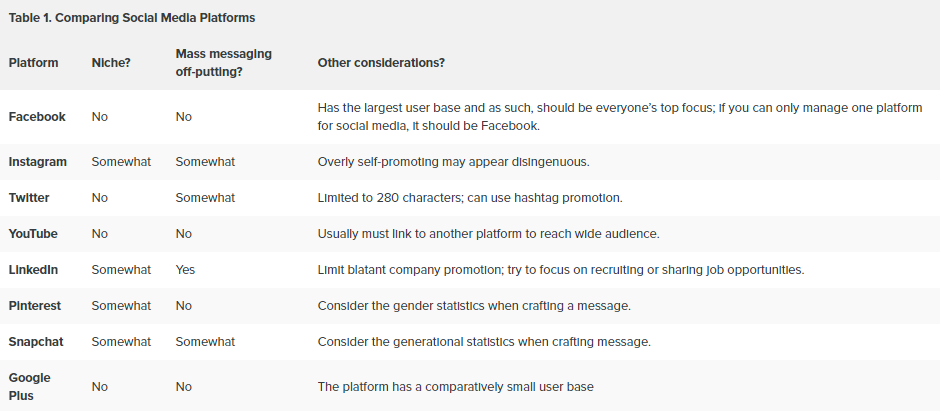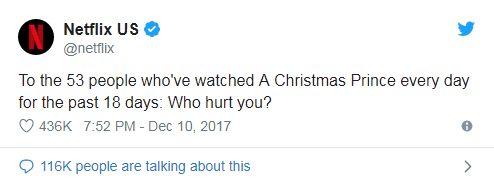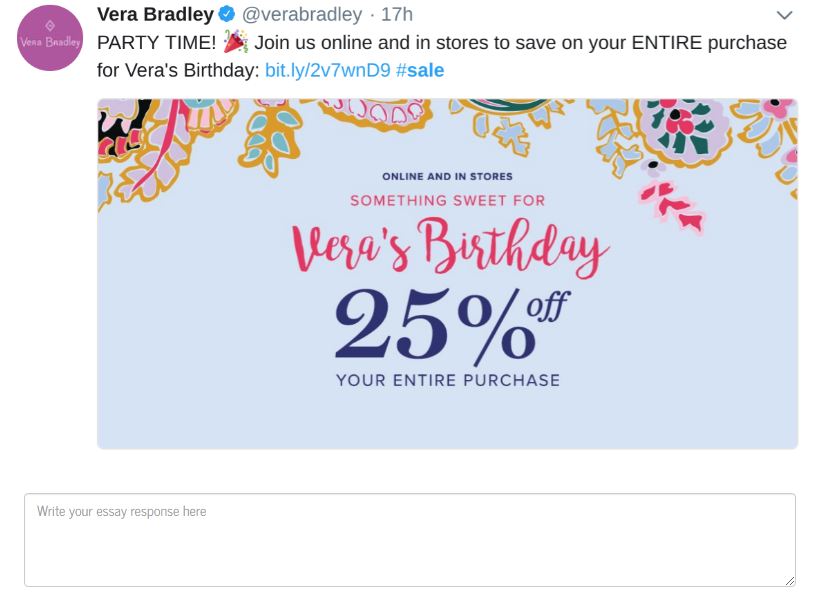10.4: Selling Your Products
- Page ID
- 4158
What you’ll learn to do: Use various types of social media to increase your sales
Recall that our goal with social media use is a positive exchange with customers around a product or service. We use social media to reach a wide audience inexpensively. This audience is both internal—our own company or organization—and external—our customers and sometimes even our vendors. Depending on your organization’s leadership, some might argue that internal communications, and getting these right, can be just as important as interaction and messaging with clients and vendors. The area of overlap between business communication and marketing, particularly with social media use, is gray.
In the following pages, we will look at contextual use of social media and place it in our framework for social media use below:
- To bring services or products to market; increase awareness.
- To engage customers, often with respect to service issues or problems.
- To encourage a “buzz” or interest around a company and its product(s) or service(s).
learning outcomes
- Use social media to announce a product launch
- Use social media to spotlight products
- Use social media to announce a sale or event
Product Launch
A key reason businesses use social media is to bring attention to a new product or service.Using social media for this purpose is inexpensive, and companies can usually reach a large audience immediately. Using social media prior to a product’s launch can help generate excitement for the upcoming product and get the attention of potential new customers.
Canva, a social media marketing blog, describes various tactics when announcing a product or service launch. Here are a few notable items from the list:[1]
- Design a hashtag. By using a hashtag, you can create a central “hub” for all posts about your new product. People posting about the product can also use this hashtag, which increases the reach of the product.
- Organize a countdown. Countdowns can increase interest over a period of time. As you release messages on a schedule, it gives more people the opportunity to get excited and ready for the product by the time it is released.
- Develop consistency across platforms. The look and feel of a Facebook post should be roughly similar to something on Pinterest or Snapchat. While this is important across all social media messaging, it’s particularly important when launching something new. If your messaging is inconsistent, people might get confused about what exactly is being released.
- Have a clear call to action. As with good web design, a social media message should be easy to interpret. You want your audience to have all the information they need to either further interact with your social media campaign or have the information they need to get your product.
mango
Let’s take a look at this tweet from Kendall Jenner on behalf of Mango (a fashion company):

Mango is doing a few things in this tweet to gain interest before launching a new product. By using a countdown, they’re growing interest (and providing a bit of mystery), so when the product launches, they’ll already have interested customers. They’re also using Kendall Jenner as a spokesperson to gain interest in their upcoming product. Kendall Jenner likely has a lot more followers than Mango, so she is able to get the company’s message out to more people. Additionally, her endorsement makes people more likely to be interested in the product once it launches.
When choosing which social media platform(s) to use for a product or service launch, you should consider the target audience and type of message. Assuming an organization has the capacity to manage a large social media portfolio, announcements of product or service launches should go out on as many appropriate platforms as possible. Some consideration should be given to “spamming” your audience, however, as well as thinking through any “niche” sensibilities around a given platform. Table 1 outlines some items along these lines:

practice question
Roxanne is putting together a social media strategy for her company to release a new line of women’s exercise leggings. Which of the following is the BEST idea for Roxanne to incorporate in her plan?
- Plan a series of countdown tweets to post on the company's Twitter feed
- Plan a series of ads to promote on Pinterest to post after the product's release
- Plan a blog post to share on LinkedIn about the new opportunities that come with the increase of the company's product line
- Answer
-
Plan a series of countdown tweets to post on the company's Twitter feed
Spotlight Products
Many of the themes covered in the recent pages are similar: we work to use real, compelling, and authentic narratives to promote interest in our organization or a given product or service, or to increase interaction with and between customers.
The key questions to consider:
- Is the message or post authentic?
- How easy have they made it to interact?
NETFLIX
In Figure 1, Netflix leverages their data analytics for viewership to make a tongue-in-cheek exchange:

Note that this single tweet was liked over 450k times, and retweeted/shared over 115k times! This Tempesta Media blog post here, discusses using humor to drive social media interest. Humor is an effective way to reveal the “story” of your brand, or in other words, the human side of your business.
Netflix also takes advantage of multimedia in this tweet spotlighting their new Facebook service, Recomoji, which sends users recommendations based on the emjois you send.

kohl's
Another good example is Kohls’ Instagram feed. In their feed, they highlight outfits of the day (using the #ootd hashtag to up their visibility by non-followers). Not only do they put together a cute look using items that can be found in their stores, but they also use these posts to highlight savings available in stores.
Beyond their #ootd posts and other product posts, Kohl’s spotlights customers and looks that their customers have purchased at the store, giving followers someone to relate to.
Recall that “the human side” of the business was something recommended in one of our previous pages on authenticity. In years past, advertisers used to argue that a brand should create a fictional “perfect” image. The famous Marlboro Man suggested that those who smoked Marlboro would take on the tough and macho air of the man himself.
The compelling story was not necessarily about being authentic but rather about being delivered from (maybe) a dreary life into something exciting and adventurous. But the Marlboro Man is not subtle or real enough for today’s wiser, media-saturated consumers. They want reality but expressed in engaging and fun ways; in short, they want humor.
The most effective tweets play on a simple and authentic interaction around core pieces of a company’s brand.
practice Question
Javier works for a company that sells shoes, and wants to use social media to promote a new brand of sandals that the company is carrying. Which of the following is the BEST idea for Javier to do in a post or tweet about the sandals?
- Include a list highlighting the attractive features of the new sandals.
- Find a way to use humor to engage potential customers.
- Create a "perfect" image of a person who wears these sandals that potential customers can imagine themselves becoming if they only buy the sandals.
- Answer
-
Find a way to use humor to engage potential customers.
Sales and Events
Advertising a Sale
Considerations for announcing a sale or event are similar to announcing new products or services. You want to create interest and excitement around the sale. You can do this by either spotlighting the size of the sale or savings, or highlighting the reason for the sale: for example, you can highlight a big fifty percent off blow-out sale or you can highlight back-to-school savings.
Of course, these aren’t the only types of sales, but these are the typical ways you would frame a sale.
patagonia
Perhaps one of the biggest sales of the year is any company’s Black Friday sale. Sales have begun starting earlier and earlier (with some “Black Friday Sales” starting over a week before Thanksgiving) as companies attempt to outdo each other in this sales space every year. In 2016, Patagonia, an outdoor clothing store, pledged to donate all sales made on Black Friday to environmental groups:

This tweet emphasizes that while they’re donating 100% during their Black Friday event, they also donate 1% of their daily revenue every other day of the year. Since their target customer base is made up of people who enjoy outdoor activities (and thus typically want to help preserve the environment), this tactic proved very successful for Patagonia.
That Black Friday, they brought in $10 million in sales (five times their expected revenue of $2 million), and they did, in fact donate all the proceeds.[2]
practice question
What did Vera Bradley do well in this tweet about their upcoming sale?

- Answer
-
They spotlighted the size of the sale (25% off), and highlighted the reason for the sale (Vera’s Birthday).
Features to Increase Sales
There are, however, some unique features of various platforms that can help promote a sale or event. One such key feature is embedding a “buy” or similar button or link in a social media message. While some platforms, most notably Facebook, have actually killed its buy button, Pinterest’s is alive and well.
- These buttons or links make it easy to buy right from your social channels
- Consider “pro” or paid accounts where you can link a buy button or feature into your post
Pinterest has a tutorial for building “buyable pins” here. The process is relatively simple, and it’s worthwhile to emphasize the ease of Pinterest’s platform. From their website:[3]
To create a Buyable Pin from scratch, just follow the standard Pin creation process. As long as the Pin’s URL points to a product detail page at your online store, the Pin will activate as a Buyable Pin.
Interestingly, buy buttons are somewhat controversial and haven’t necessarily been successful on all social media platforms:[4]
A study by the University of Massachusetts Dartmouth reported that only 35% of millennials were likely to use buy buttons on Facebook and just 24% were likely to use buy buttons on Twitter. As of now [March 2017] both Facebook and Twitter have decided to drop social buy buttons altogether.
Assuming your audience has a Millennial or Generation Z component, and especially if that also cross-references to a female audience, using Pinterest’s and Snapchat’s buy features is probably a wise move. Snapchat’s percentage in the above graphic is small, but this data was taken in 2016. In a more recent 2018 article on prominent social media watcher Mashable, they argue that Snapchat’s brand and buy filters are that platform’s strongest feature:[5]
[Snapchat] launched a new form of branded lenses called “shoppable” lenses . . . , which allow brands to apply buy buttons and prompts to install ads directly into a lens. Think of it as Snapchat’s version of Instagram’s “buy now” ads.
- Jose, Maria. "10 tactics for launching on social media and generating buzz, inspired by companies who've done it." Canva. Web. 15 July 2018. ↵
- Kavilanz, Parjia. "Patagonia's Black Friday sales hit $10 million -- and will donate it all." CNN Tech. 29 Nov 2016. Web. 10 July 218. ↵
- https://business.pinterest.com/en/ge...h-buyable-pins ↵
- Malone, Matt. "What Are Social Buy Buttons?" Gravitate Design. 10 Apr 2017. Web. 10 July 2018. ↵
- Bell, Karissa. "Snapchat just proved why lenses are a bigger deal than Stories." Mashable. 18 Apr 2018. Web. 10 July 2018. ↵

